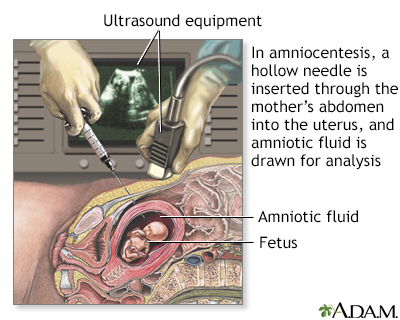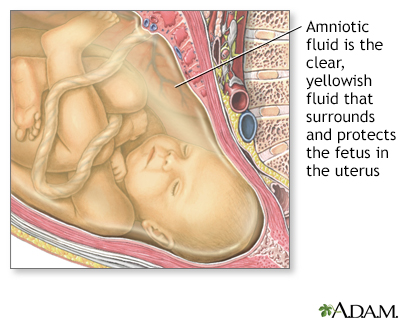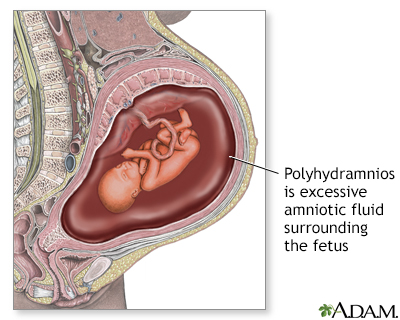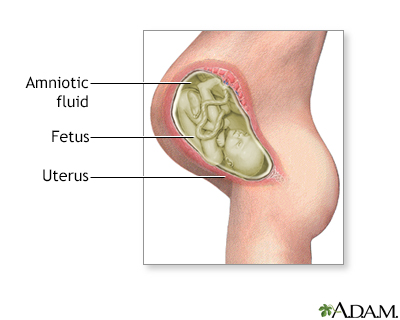Amniotic fluid
Amniotic fluid is a clear, slightly yellowish liquid that surrounds the unborn baby (fetus) during pregnancy. It is contained in the amniotic sac.
Images




Animation

Information
While in the womb, the baby floats in the amniotic fluid. The amount of amniotic fluid is greatest at about 34 weeks into the pregnancy (34 weeks gestation), when it averages 800 milliliters (mL). About 600 mL of amniotic fluid surrounds the baby at full term (40 weeks gestation).
The amniotic fluid constantly moves (circulates) as the baby swallows and "inhales" the fluid, and then releases it.
The amniotic fluid helps:
- The developing baby to move in the womb, which allows for proper bone growth
- The lungs to develop properly
- Prevent pressure on the umbilical cord
- Keep a constant temperature around the baby, protecting from heat loss
- Protect the baby from outside injury by cushioning sudden blows or movements
Too much amniotic fluid is called polyhydramnios. This condition can occur with multiple pregnancies (twins or triplets), congenital anomalies (problems that exist when the baby is born), or gestational diabetes.
Too little amniotic fluid is known as oligohydramnios. This condition may occur with late pregnancies, ruptured membranes, placental dysfunction, or fetal abnormalities.
Abnormal amounts of amniotic fluid may cause the health care provider to watch the pregnancy more carefully. Removing a sample of the fluid through amniocentesis can provide information about the sex, health, and development of the fetus.
References
Burton GJ, Sibley CP, Jauniaux ERM. Placental anatomy and physiology. In: Landon MB, Galan HL, Jauniaux ERM, et al, eds. Gabbe's Obstetrics: Normal and Problem Pregnancies. 8th ed. Philadelphia, PA: Elsevier; 2021:chap 1.
Gilbert WM. Amniotic fluid disorders. In: Landon MB, Galan HL, Jauniaux ERM, et al, eds. Gabbe's Obstetrics: Normal and Problem Pregnancies. 8th ed. Philadelphia, PA: Elsevier; 2021:chap 28.
Ross MG, Beall MH. Amniotic fluid dynamics. In: Lockwood CJ, Copel JA, Dugoff L, et al, eds. Creasy and Resnik's Maternal-Fetal Medicine: Principles and Practice. 9th ed. Philadelphia, PA: Elsevier; 2023:chap 4.
BACK TO TOPReview Date: 10/15/2024
Reviewed By: John D. Jacobson, MD, Professor Emeritus, Department of Obstetrics and Gynecology, Loma Linda University School of Medicine, Loma Linda, CA. Also reviewed by David C. Dugdale, MD, Medical Director, Brenda Conaway, Editorial Director, and the A.D.A.M. Editorial team.

Health Content Provider
06/01/2025
|
A.D.A.M., Inc. is accredited by URAC, for Health Content Provider (www.urac.org). URAC's accreditation program is an independent audit to verify that A.D.A.M. follows rigorous standards of quality and accountability. A.D.A.M. is among the first to achieve this important distinction for online health information and services. Learn more about A.D.A.M.'s editorial policy, editorial process and privacy policy. A.D.A.M. is also a founding member of Hi-Ethics. This site complied with the HONcode standard for trustworthy health information from 1995 to 2022, after which HON (Health On the Net, a not-for-profit organization that promoted transparent and reliable health information online) was discontinued. |
The information provided herein should not be used during any medical emergency or for the diagnosis or treatment of any medical condition. A licensed medical professional should be consulted for diagnosis and treatment of any and all medical conditions. Links to other sites are provided for information only -- they do not constitute endorsements of those other sites. © 1997- 2025 A.D.A.M., a business unit of Ebix, Inc. Any duplication or distribution of the information contained herein is strictly prohibited.
